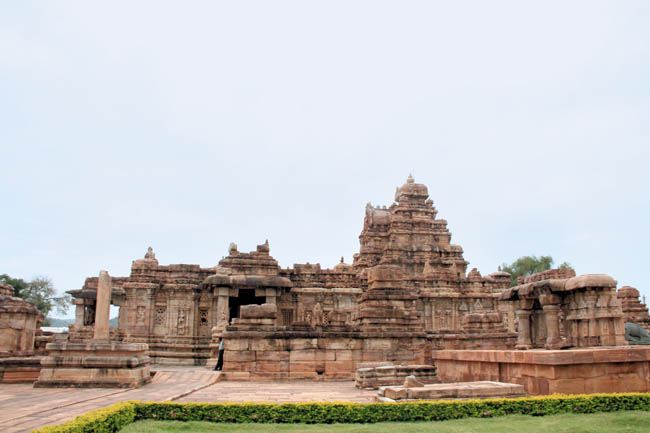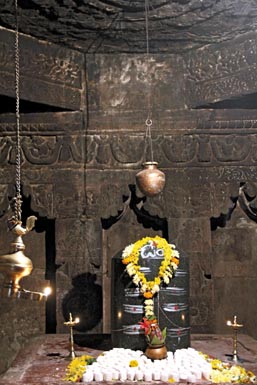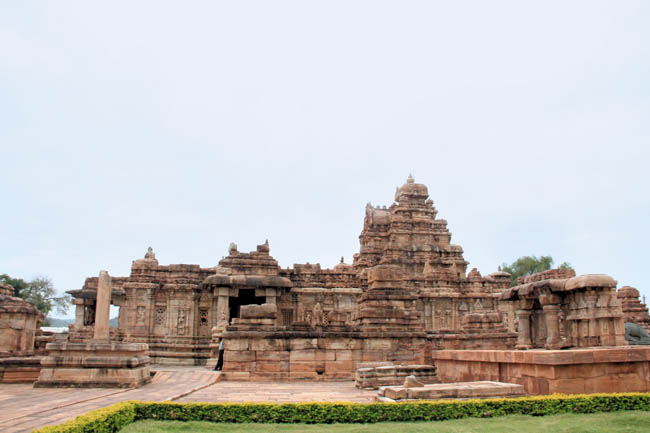In the kingdom red
Capture the splendid history of Chalukya dynasty and experiences the poetry set in red sandstone.

Once upon a time, more than a millennia ago,there was a kingdom positioned at the rugged feet of red sandstone hills.The capital of the kingdom, Vatapi, was carved out of stone and sprawled around the ravine of the Agastya Lake. The Chalukyas ruled there for more than two centuries, from the 6th to the 8th. As everything is ephemeral, their transient rule passed. What has remained is a memory of the splendid history, eternalised in stones.
The rock-cut civilisation of Hampi on the banks of Tungabhadra had left us overwhelmed and Badami reckoned with a similar promise. So we drove down from Mumbai on the national highways that led us to the dusty country roads to Badami in the Bagalkot district of Karnataka. As you enter the town you see it flanked by red sandstone cliffs that are popular for rock climbing and bouldering. Though the town is crowded with pilgrims, locals, sounders of pigs and flocks of kids, the sunset coloured rocks glowing warmly at a distance make up for all your trouble.
 On one side of the Agastya lake are the cave temples and on the other, the Bhootnath temple, the fort and the museum. The most visited are the four rock-cut caves on a steep sandstone ridge. Magnificent in detail, the first cave is devoted to Shiva, the second and third to Vishnu and the last to Jain Tirthankars. The third cave is jaw dropping with spectacular carvings, massive in built. The last cave, the simplest of all, faces the serene vistas of the lake.
On one side of the Agastya lake are the cave temples and on the other, the Bhootnath temple, the fort and the museum. The most visited are the four rock-cut caves on a steep sandstone ridge. Magnificent in detail, the first cave is devoted to Shiva, the second and third to Vishnu and the last to Jain Tirthankars. The third cave is jaw dropping with spectacular carvings, massive in built. The last cave, the simplest of all, faces the serene vistas of the lake.
The highlight of Badami for me was the bewitching Bhootnath temple located at the far end of the lake, sitting still like a hermit lost to the world with the waves trying to distract him with small laps, like a puppy lapping the feet of a sleeping master. As you sit on the cool rocks of the temple in the evening, the warm globe of the sun sets beyond the lake, dipping down the horizon above the sleepy town.
The small lakeside museum approachable on the way to Bhootnath temple hosts quite an interesting piece of sculpture—an intact statue of the faceless, lotus-headed Lajja Gauri. One of the most ancient goddesses, sitting with her legs spread apart, she is the image of regeneration and reproduction. In a culture that has worshipped fertility, the cult of this divine feminine once spread prodigiously. Its decline is attributed to the emergence of the Victorian morality.
Badami, believed to have been named after the colour of badam (almond), is not just poetry set in red sandstone. It’s a raga that echoes for miles. The Chalukya monuments spread all around Badami. Mahakuta, a nearby village, is the site of Chalukya temples constructed in the 6th century. Though Mahakuta is a place for Shiva worship, the Banashankari temple to the south of Badami is more popular with pilgrims, who flock there in large numbers in January or thereabouts to witness the Badami Goddess doing her yearly rounds around the town in a colourful, flower-abounding rath yatra.
Aihole, another village located near Badami, has 125 rock temples dating back to the 5th century. It was the first capital of the Chalukyas and shoulders the weighty title of being the cradle of Hindu rock architecture. It boasts some of the earliest rock-cut shrines. The most interesting of the Aihole temples is a group of three temples called
Kontigudi. The Durga temple is stunning and has an intricately carved corridor replete with “amorous couples” (as the guide books and information boards proclaim over and over again) meticulous in artistry, unabashed in postures. The Lad Khan temple has latticed windows that filter the light inside like sprays from an illuminated fountain.

Not to be missed while treading the Chalukya ruins is Pattadakal, a world heritage site 22 km from Badami, the place for Chalukya coronation. The temples and inscriptions in this complex leave the tourists wondering and the scholars scribbling. Virupaksha is the largest temple in Patadakal, built by King Vikramaditya’s wife Lokamahadevi to mark his three war-victory over Pallavas. A smaller version of this temple stands near it, and was built by Vikramaditya’s second wife, also to commemorate his three war victory over Pallavas!
As you explore Bagalkot’s countryside you cross and travel along river Malaprabha. You might chance upon a grey heron ruminating about fish, sunflowers nodding their sunny faces to the wind, shiny bald heads of rocks jutting out of the riverbed, debonair Indian Rollers shying away on the small winding country roads. The bird life of the area is as vibrant and pulsating as the monuments are stoic and still.
When you return to the towering ridges of Badami after each excursion, you can feel the blood flowing auburn in your veins, drunken with the red sandstone. But, unlike the touristy Hampi, the staying options in Badami are not wide-ranging. Although a little on the steeper side, they can easily fit in a mid-sized pocket.
The perfect place to end your Badami sojourn is the Agastya temple. You can just sit there pondering like the grey heron, not about fish but maybe about the asura Vatapi who was killed by sage Agastya. The legend says Ilvala went about luring vagrants and serving them mouthwatering ram, which was actually his brother Vatapi. Once the vagrant would gorge on the meat, Ilvala would call out Vatapi’s name and the latter would come bursting out of the vagrant’s stomach, a straight returnee from netherland. Pretty gross. But this trick didn’t work with sage Agastya, who quickly digested Vatapi and even burped before Ilvala could call his name. Victory of bad over evil. So the lake got named after Agastya and the kingdom’s capital got named after Vatapi. Fancy that. But that was a long time ago. Today, we might fail to tell the difference between the good and the good old evil. Devil wears Prada, after all.
The information:
Reaching Badami
Located in the Bagalkot district of North Karnataka, it is convenient to reach Badami by air, rail or road.
By air: Nearest airports to Badami are Hubli (around 106 km) and Belgaum (around 150 km). These airports have connectivity to Bengaluru and Mumbai.
By train: The Badami railway station is connected to Bengaluru, Hubli, Bijapur, Solapur and other cities, with Hubli as the nearest major rail junction.
By road: You can reach Badami by road from Hubli, Dharwad, Belgaum, Bengaluru, Bagalkot, Hampi, Bijapur, and many other cities.
The writer is an author, columnist, and hon. wildlife warden, Udaipur









